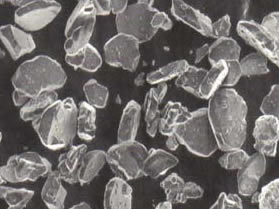Alumina Polishing Abrasives
There are a number of different types of alumina polishing abrasives. These abrasive are classified by there manufacturing process, crystal structure (hardness) and their classification process. The main types of alumina’s produced for polishing are either calicned or polycrystalline alumina. Calcined powders can also be characterized as either fused, platey or levigated (air classified / sized) alumina depending upon the grain shape, purity and classification process. There is a major difference in the performance between calcined and polycrystalline alumina abrasives, especially for the submicron particle sizes. The two common crystal structures are the harder alpha alumina (mohs hardness 9) and the softer gamma crystal structure (mohs hardness 8).
| Alumina / property | Polycrystalline | Calcined | Fused | Levigated |
| Crystal structure | Polycrystalline alpha alumina | Monocrystalline alpha alumina | Alpha alumina | Monocrystalline gamma or alpha |
| Shape | Hexagonal platelets | Hexagonal platelets | ||
| Particle size | 0.10, 0.15, 0.20 micron | Submicron up to 30 microns | 5-70 micron | 3-5 micron (air classified) |
| pH | 4 and 10 | Range from 8-11 | 9.0-10.5 | |
| % solids | 20-30% | |||
| Specific gravity | 3.95 gms/cc | 3.95 gms/cc | 3.95 gms/cc | 3.95 gms/cc |
| Hardness | Knoop 2000 (Mohs 9) |
Knoop 2000 (Mohs 9) |
Knoop 2000 (Mohs 9) | Mohs 8,9 |
| Applications | pH 4 (acidic) – metal polishing pH 10 (basic)- ceramic polishing |
Linde A, Linde B and Linde C alumina polishes |
Calcined and Fused Alumina
Calcined alumina powders are typically used for metal lapping and polishing, as well as have been the traditional rough and final polishing abrasive for many years and is relatively inexpensive and readily available.
Calcined alumina grains consist of single platey crystals, whereas fused alumina is more blocky in shape. A perfect clacined alumina particle would be a six-sided disk, with a thickness of about 1/5 of its diameter.

Calcined alumina are typically very pure (>99%), whereas the purity of fused alumina can vary from 96% to 99+%.. The issue with the calcined powders is the agglomeration issue created by processing these type of alumina’s as dry powders creates agglomeration of the particles. For larger particles (>600 grit), the agglomeration is not too much of an issue, however for smaller particles the agglomeration issue can be significant. For example, the agglomerated or standard version of a 0.05 um aluimina crystal can form an agglomerate size as large as 40 um. When polishing hard samples these agglomerates can often be broken down, however for soft materials such as aluminum, copper, zinc, etc. these fine agglomerated abrasives can form large random scratches.
Agglomerated vs. Deagglomerated
The term agglomeration refers to the electrostatic attraction of small particles to each other. This arises from the fact that all surfaces have an unbalanced surface charge. When the surface area of small alumina particle becomes large compared to its volume, then it becomes nearly impossible to keep the particle from attracting each other in a dry processing state.
The term deagglomeration refers to the process by which a dry agglomerated particle is milled or broken down. The process for deagglomeration of dry powders is to blast the agglomerated powder at each other at high velocities, thus breaking down the agglomerate size. The process is only moderately successful.
Polycrystalline Aumina
Polycrystalline or nanometer alumina is a colloidal alumina processed by a proprietary process which produces a polycrystalline alumina crystal. This processing offers two significnat improvements over conventional alumina calcining processes:
- Tighter more controlled particle size distributions
- Harder alpha alumina phase

A tighter more controlled particle size distribution is a result of less particle aggregation. For example, standard calcined 0.05 um gamma alumina products form aggregate sizes as large as 5 um. These aggregates can be broken down during polishing with harder specimens. However, these large aggregates have been known to cause significant scratching in soft metals such as aluminum, tin, lead, copper and soft steels.
Nanometer alumina is specifically milled to produce a much smaller aggregate particle size distribution (<0.5 um). Nanometer alumina is also the harder alpha alumina particle, therefore making it a more efficient cutting abrasive. Thus nanometer alumina is a much more controlled polishing abrasive than calcined gamma alumina.
Advantages and Features of Nanometer Alumina
- Improved surface finishes over gamma alumina
- Less random scratching
- Higher cutting rates than gamma alumina
- Much more uniform surface finish
- Tighter particle size distributions than gamma alumina
- Low viscosity for easy dispensing
- Semi-permanent suspensions
Application of Nanometer Alumina
- The most efficient application is to initially wet the polishing cloth with Nanometer alumina and then to slowly drip or spray the suspension onto the polishing cloth
Alumina Product Specifications
Alumina Powders
Alumina Type |
Crystal |
Form |
Hardness (mohs) |
Particle Size (microns) |
Part Number |
Levigated |
Gamma, Linde B |
Deagglomerated powder |
8 |
0.05 |
|
Alpha, Linde A |
9 |
0.30 |
|||
Calcined |
Alpha |
Powder |
9 |
0.5 1.0 3.0 5.0 |
|
Fused |
Alpha |
Powder |
9 |
240 400 600 |
Alumina Slurry / Suspensions
Alumina Type |
Crystal |
Hardness |
pH |
Particle Size (microns) |
Part Number |
Polycrystalline |
Alpha |
9 |
10 4 |
0.05 |
NA-1005 NA-1020 |
Calcined |
Alpha |
9 |
0.05 |
NANO-1005 NANO-1003 NANO-1050 NANO-1100 NANO-1300 NANO-1500 |
